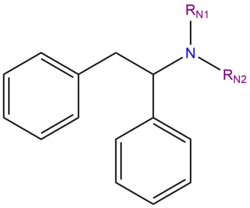Diarylethylamines: Difference between revisions
>Unity m Grammatics |
>Unity Added details |
||
| Line 1: | Line 1: | ||
{{stub}} | {{stub}} | ||
[[File:Diarylethylamine.png|250px|thumbnail| | [[File:Diarylethylamine.png|250px|thumbnail|General chemical structure of a diarylethylamine]] | ||
'''Diarylethylamines''' are a class of [[psychoactive substances]] that produce [[dissociative]] effects when [[administered]]. [[Subjective effects]] are similar to those of [[arylcyclohexylamine]] dissociatives like [[PCP]] or [[ketamine]], although they differ in their chemical structure. | '''Diarylethylamines''' are a chemical class of [[psychoactive substances]] that produce [[dissociative]] effects when [[administered]]. [[Subjective effects]] are similar to those of [[arylcyclohexylamine]] dissociatives like [[PCP]] or [[ketamine]], although they differ in their chemical structure. | ||
Diarylethylamines are examples of contemporary designer drugs specifically chosen to mimic and/or replace the functional and structural features of commonly used illicit substances. They have been marketed on the online research chemicals market as a replacement for MXE and other dissociatives. | Diarylethylamines are examples of contemporary designer drugs specifically chosen to mimic and/or replace the functional and structural features of commonly used illicit substances. They have been marketed on the online research chemicals market as a replacement for MXE and other dissociatives. | ||
| Line 55: | Line 55: | ||
|} | |} | ||
===Examples=== | ===Examples=== | ||
* [[Diphenidine]] | * [[Diphenidine]] | ||
* [[Ephenidine]] | * [[Ephenidine]] | ||
| Line 61: | Line 60: | ||
==See also== | ==See also== | ||
* [[Responsible use]] | * [[Responsible use]] | ||
* [[Dissociative]] | * [[Dissociative]] | ||
Revision as of 03:58, 22 April 2019
 |
This article is a stub. As such, it may contain incomplete or wrong information. You can help by expanding it. |

Diarylethylamines are a chemical class of psychoactive substances that produce dissociative effects when administered. Subjective effects are similar to those of arylcyclohexylamine dissociatives like PCP or ketamine, although they differ in their chemical structure.
Diarylethylamines are examples of contemporary designer drugs specifically chosen to mimic and/or replace the functional and structural features of commonly used illicit substances. They have been marketed on the online research chemicals market as a replacement for MXE and other dissociatives.
Very little is known about the human pharmacology, metabolism, and toxicity of these compounds. Many reports suggest that they may pose different and more pronounced risks than traditional dissociatives.
Pharmacology
| Compound | IC50 ± SEM (nM) | Ki ± SEM (nM) |
|---|---|---|
| PCP[2] | 91 ± 1.3 | 57.9 ± 0.8 |
| Ketamine | 508.5 ± 30.1 | 323.9 ± 19.2 |
| Memantine | 594.2 ± 41.3 | 378.4 ± 26.3 |
| (+)-MK-801 | 4.1 ± 1.6 | 2.5 ± 1.0 |
| DPH (Diphenidine) | 28.6 ± 3.5 | 18.2 ± 2.2 |
| 2-MXP (Methoxphenidine) | 56.5 ± 5.8 | 36.0 ± 3.7 |
| 3-MXP | 30.3 ± 2.6 | 19.3 ± 1.7 |
| 4-MXP | 723.8 ± 69.9 | 461.0 ± 44.5 |
| 2-Cl-DPH | 14.6 ± 2.1 | 9.3 ± 1.3 |
| NMDAR binding affinites determined using [3H]-(+)-MK-801 in rat forebrain.[3] | ||
Examples
See also
Literature
- Wallach, J., Kang, H., Colestock, T., Morris, H., Bortolotto, Z. A., Collingridge, G. L., ... & Adejare, A. (2016). Pharmacological investigations of the dissociative ‘legal highs’ diphenidine, methoxphenidine and analogues. PLoS One, 11(6), e0157021. https://doi.org/10.1371/journal.pone.0157021
- Morris, H., & Wallach, J. (2014). From PCP to MXE: A comprehensive review of the non-medical use of dissociative drugs. Drug Testing and Analysis, 6(7–8), 614–632. https://doi.org/10.1002/dta.1620
- Wallach, J., & Brandt, S. D. (2018). 1, 2-Diarylethylamine-and Ketamine-Based New Psychoactive Substances. In New Psychoactive Substances (pp. 305-352). Springer, Cham. http://dx.doi.org/10.1007/164_2018_148